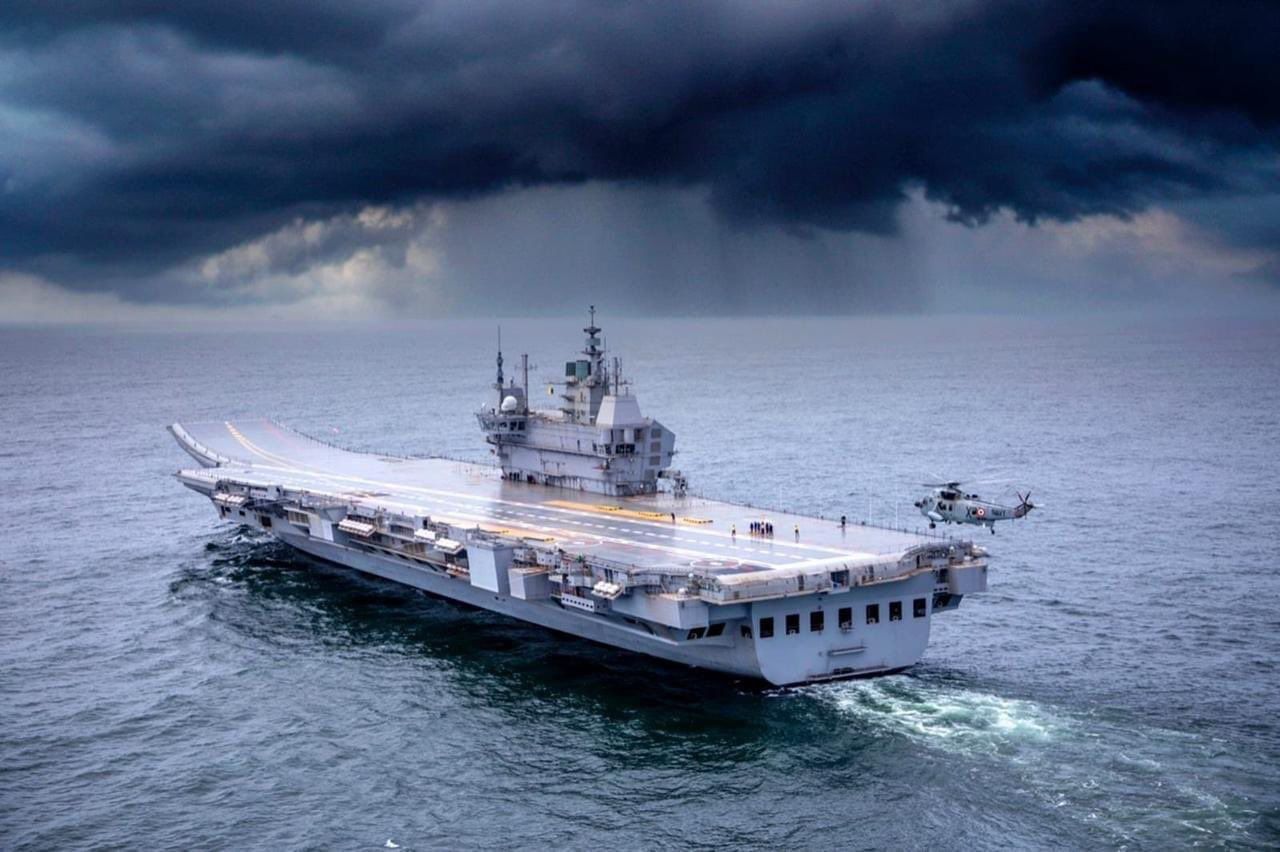As the entire country was washed with the glow of millions of earthen lamps lit up to celebrate Diwali, the Indian Navy achieved an important milestone as India’s first indigenously-built aircraft carrier INS Vikrant, achieved “fully operational status”. The development puts India in the elite group of countries capable of constructing aircraft carriers and deploying them.
Before this, the Indian Navy only had one operational aircraft carrier, INS Vikramaditya, purchased from Russia.
The EurAsian Times has learned that the indigenous aircraft carrier (IAC) built at Cochin Shipyard Limited achieved “fully operational status” on Diwali. The aircraft carrier is ready to be deployed now, a source said, requesting anonymity.
The development comes at a time when China has been asserting its maritime might in the Indian Ocean Region and is conducting maritime drills with Pakistan.
“We now have fully operational two Carrier Battle Group which greatly enhances our operational capability, our ability to project power in our areas of interest and reinforces our pre-eminent maritime presence in the Indian Ocean Region,” Commodore Anil Jai Singh (retired) told the EurAsian Times while talking about the development.
He added: “China will be taking note of this – it is aware that it is still some distance away from challenging India in the Indian Ocean and is therefore unlikely to do anything provocative in these waters.”
The construction of the ambitious project to build the 44,000-ton warship started in 2013. The Navy took a major step towards operationalizing INS Vikrant by successfully conducting the landing of an indigenous Light Combat Aircraft (Navy) and MiG-29K on INS Vikrant in the Arabian Sea.
In June 2023, the Indian Navy gave a glimpse of how its multi-carrier operations will look in the future by demonstrating the coordinated deployment of two carrier battle groups along with more than 35 aircraft in the Arabian Sea. The exercise involved the seamless integration of two Aircraft Carriers, INS Vikramaditya and the indigenously built INS Vikrant- along with a diverse fleet of ships, submarines, and aircraft.
INS Vikramaditya and INS Vikrant, centerpieces of the exercise, serve as ‘floating sovereign airfields,’ providing a launch platform for a wide array of aircraft, including MiG-29K fighter jets, MH60R, Kamov, Sea King, Chetak, and ALH helicopters. “As India continues to strengthen its security apparatus, the significance of Aircraft Carriers will remain paramount in shaping the nation’s defense strategy and promoting regional stability,” the Indian Navy said in a press release.
Analysts said it is a big accomplishment that only the United States Navy has pulled off in recent memory. “This is not a small achievement and underlines that the Indian Navy is one of very few in the world that operates more than one aircraft carrier,” Nick Childs, senior fellow for naval forces and maritime security at the International Institute for Strategic Studies (IISS), told the CNN after the demonstration.
Upon Vikrant’s commissioning in 2022, India joined only the United Kingdom and China in commissioning a domestically built aircraft carrier in the previous three years. But while both China and the UK have more than one aircraft carrier in their modern fleets, neither has yet to perform dual-carrier operations with them, analysts said.
The Indian Navy has been working towards maintaining a three-carrier force with the ability to deploy one carrier on each coast at any given time while one undergoes refit.
The aircraft carrier has undergone four phases of rigorous trials to validate all the systems on board in what will be a “floating sovereign airfield.”
INS Vikrant was inducted on September 2, 2022, when Prime Minister Narendra Modi commissioned India’s first indigenous aircraft carrier, Indian Naval Ship (INS) Vikrant, at the Cochin Shipyard Limited (CSL).
“Vikrant is not just a warship. This is a testament to India’s hard work, talent, influence, and commitment in the 21st century. If the goals are distant, the journeys are long, the ocean and the challenges are endless – then India’s answer is Vikrant,” PM Modi said.

INS Vikrant’s Journey To Sea
In December 2019, the engines of the aircraft carrier were fired up. By September 2020, Vikrant had completed harbor trials, while the basin trials started in October 2020 to check propulsion, electric transmission, and shafting systems. On November 30, 2020, the basin trials were completed, paving the way for sea trials, the final phase of the IAC-I project.
In April 2021, work began to integrate the long-range surface-to-air missile (Barak-8) onboard Vikrant. In August 2021, the first phase of the sea trials was completed. The second phase of the trials was conducted in October 2021, followed by the third phase in January 2022, both of which were completed successfully.
On July 10, the fourth and final phase of the sea trials was completed. This phase involved integrated trials of most of the equipment and systems aboard Vikrant, including portions of the Aviation Facilities Complex.
On May 26, 2023, a MiG-29K successfully landed on its deck during night sea trials. Earlier, the naval version of the indigenously-built LCA Tejas successfully landed on INS Vikrant as part of the sea trials. LCA Tejas is the first fixed-wing aircraft to land on the flight deck of Vikrant.
The 262 m long and 62 m wide Vikrant displaces approximately 43000 T when fully loaded, having a maximum designed speed of 28 Knots with an endurance of 7500 NM.
The ship has around 2200 compartments, designed for a crew of about 1600, that include specialized cabins to accommodate women officers and sailors. The carrier is designed with a very high degree of automation for machinery operations, ship navigation, and survivability.
The ship would be capable of operating an air wing consisting of 30 aircraft comprising of MiG-29K fighter jets, Kamov-31, MH-60R multi-role helicopters, in addition to indigenously manufactured Advanced Light Helicopters (ALH) and Light Combat Aircraft (LCA) (Navy).
Using a novel aircraft-operation mode known as Short Take-Off But Arrested Recovery (STOBAR), the IAC is equipped with a ski jump for launching aircraft and a set of three ‘arrester wires’ for their recovery onboard.
PLA Navy vs Indian Navy
China has two aircraft carriers in service, the Soviet-built Liaoning and the domestically-built Shandong, while a third carrier, the Fujian, has been launched but not commissioned.
India commissioned its first aircraft carrier in 1961 and added a second in 1987. It has operated two aircraft carriers on two previous occasions, between 1987 and 1997 and between 2013 and 2017. The Indian Navy press release after the twin Carrier Battle Groups exercise called the carriers “floating sovereign airfields,” adding that “they provide our friends with an assurance that the Indian Navy is capable and ready to support our ‘collective’ security needs in the region.”
- Ritu Sharma has been a journalist for over a decade, writing on defense, foreign affairs, and nuclear technology.
- She can be reached at ritu.sharma (at) mail.com
- Follow EurAsian Times on Google News




